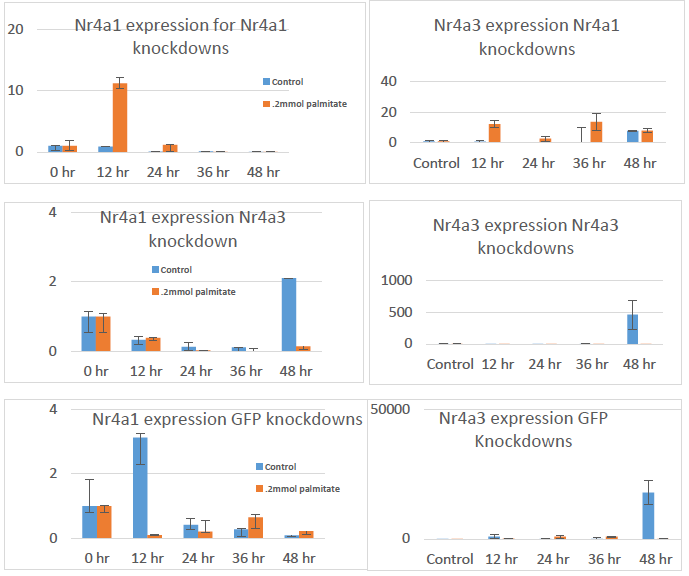Jordan Tingey and Jeffery Tessem, Nutrition, Dietetics, and Food Science
This project focused on the effects of palmitate on transcription factors, Nr4a1 and Nr4a3. All experiments were preformed on a beta cell line. The first experiment was done to show if palmitate effected proliferation of Nr4a1 and Nr4a3 knockout cell lines. This experiment was preformed adding .2 mmol palmitate to all cells and comparing them to untreated and treated unknocked down cell lines. This showed exactly what was expected which was that proliferation was decreased in Nr4a1 and Nr4a3 knockdown cell lines.
The next two experiments were to see palmitates effect on Nr4a1 and Nr4a3 expression in normal cell lines and then in knockdown cell lines. These experiments were set up in the same manner except in the second experiment three cell lines were used; siNr4a1, siNr4a3 and siGFP. Three experiments were performed on each cell line and were done over a 6 day period. Cells were added to each plate and when they were 80% confluent (roughly 3 days) the 48 hour experiment would progress. This experiment was set up by having four dishes for every 12 hour time period (24 hour time period for first experiment). Two of the plates were treated with normal media while the other two were treated with .2mmol palmitate media. At each time point I collected one dishes from each group for citrate synthase by spinning down the cells and resuspending the cells in 500 microliters of citrate synthase buffer. Then I collected one dish for each group for RNA. I followed the same procedure except I resuspened the cells in 500 microliters of Tri reagent. All these samples were stored in the -80 freezer.
Real time polymerase chain reaction was then ran on all samples for Nr4a1, Nr4a3 and PPIA (control) with the following results.
The results for the first experiment were just as expected. Palmitate was shown to increase expression of both Nr4a1 and Nr4a3. The results for the knockdown experiment were surprising. Each graph has at least one large outlier but if that is taken out a trend is usually seen. This experiment shows a good knock out of Nr4a3 and Nr4a1. However, when you are looking at Nr4a1 expression on the Nr4a3 knockdowns and the Nr4a3 expression on the Nr4a1 knockdowns, a decreasing trend is observed. This is the opposite of what we were expecting. One possible explanation is Nr4a1 and Nr4a3 are codependent and when one is knockdown the other is affected.
I then conducted a citrate synthase experiment to see the effect of palmitate on the mitochondrial output for beta cells and beta cell knock down cell lines. The results for these experiments were inconclusive. I believe the next step for this experiment would be to look into a new protocol and into a new way of analyzing the data received. Based on the rest of the data I have received it is expected that palmitate would have an effect on mitochondrial output and it is believed that with a new protocol this data can be found.
The next step for this research would be to do research with other fatty acids that have a correlation with diabetes. One possible area of research would be repeating the same research completed but with oleate instead of palmitate. When this research is complete the research could be continued with palmitate and oleate ratios.



